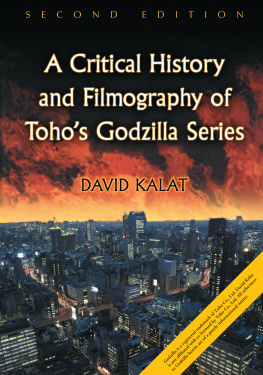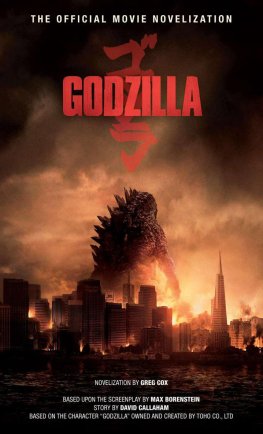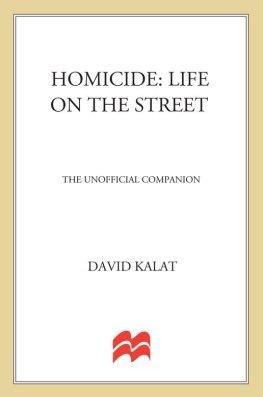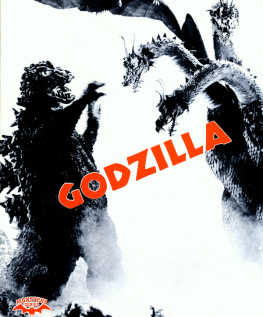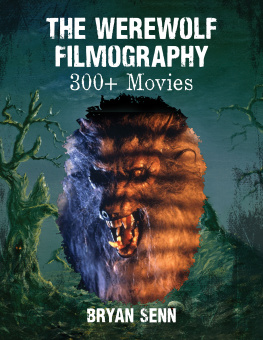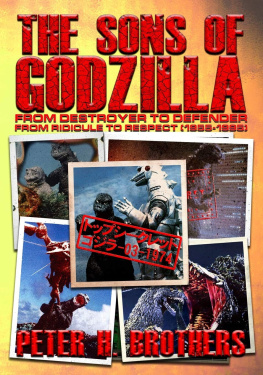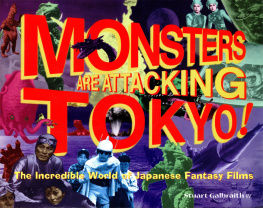David Kalat - A Critical History and Filmography of Toho’s Godzilla Series
Here you can read online David Kalat - A Critical History and Filmography of Toho’s Godzilla Series full text of the book (entire story) in english for free. Download pdf and epub, get meaning, cover and reviews about this ebook. year: 2018, publisher: McFarland, genre: Art. Description of the work, (preface) as well as reviews are available. Best literature library LitArk.com created for fans of good reading and offers a wide selection of genres:
Romance novel
Science fiction
Adventure
Detective
Science
History
Home and family
Prose
Art
Politics
Computer
Non-fiction
Religion
Business
Children
Humor
Choose a favorite category and find really read worthwhile books. Enjoy immersion in the world of imagination, feel the emotions of the characters or learn something new for yourself, make an fascinating discovery.
- Book:A Critical History and Filmography of Toho’s Godzilla Series
- Author:
- Publisher:McFarland
- Genre:
- Year:2018
- Rating:5 / 5
- Favourites:Add to favourites
- Your mark:
- 100
- 1
- 2
- 3
- 4
- 5
A Critical History and Filmography of Toho’s Godzilla Series: summary, description and annotation
We offer to read an annotation, description, summary or preface (depends on what the author of the book "A Critical History and Filmography of Toho’s Godzilla Series" wrote himself). If you haven't found the necessary information about the book — write in the comments, we will try to find it.
David Kalat: author's other books
Who wrote A Critical History and Filmography of Toho’s Godzilla Series? Find out the surname, the name of the author of the book and a list of all author's works by series.
A Critical History and Filmography of Toho’s Godzilla Series — read online for free the complete book (whole text) full work
Below is the text of the book, divided by pages. System saving the place of the last page read, allows you to conveniently read the book "A Critical History and Filmography of Toho’s Godzilla Series" online for free, without having to search again every time where you left off. Put a bookmark, and you can go to the page where you finished reading at any time.
Font size:
Interval:
Bookmark:

Also by DAVID KALAT
AND FROM MCFARLAND
The Strange Case of Dr. Mabuse: A Study of the Twelve Films and Five Novels (2001; paperback 2005)
Godzilla is a registered trademark of Toho Co., Ltd.
David Kalat is not affiliated with or
licensed by Toho Co., Ltd.
All references to Godzilla herein are of a purely
informational nature.

McFarland & Company, Inc., Publishers
Jefferson, North Carolina
LIBRARY OF CONGRESS CATALOGUING DATA ARE AVAILABLE
BRITISH LIBRARY CATALOGUING DATA ARE AVAILABLE
e-ISBN: 978-1-4766-3265-0
2010 David Kalat. All rights reserved
No part of this book may be reproduced or transmitted in any form or by any means, electronic or mechanical, including photocopying or recording, or by any information storage and retrieval system, without permission in writing from the publisher.
Cover image 2017 Photodisc
McFarland & Company, Inc., Publishers
Box 611, Jefferson, North Carolina 28640
www.mcfarlandpub.com
For Haven and Spencer Lisek,
for reminding me that monsters
can be at least half real.
When I first started to try to make my way in the world as a professional film historian, I was frustrated and discouraged thatat that moment in timeGodzilla had never received any serious consideration from anyone. The best one could find in terms of critical discussion of this phenomenon of popular culture was dismissive or contemptuous, and often riddled with factual errors and misunderstandings.
I stepped into that breach to try to correct the record. I was not the first in this mission nor was I ever aloneI was consciously following in the footsteps of Stuart Galbraith IV, and reliant on the research published by J.D. Lees in the magazine G-Fan. Ed Godzizewski, Steve Ryfle, Guy Mariner Tucker, Robert Biondi, David Milner, Jrg Buttgereit ... these are just some of the names of the researchers and fans from whom I ... stole, I guess you could say.
This underground community of scholars and fans connected the dots to tell a story that otherwise went largely unreported in the Western press, unknown to all but the true believers. They chronicled a pop cultural institution of global reachone that, at the time I was writing in the mid1990s, was still treated with ignorance and contempt by the American critical establishment.
In the original 1997 edition of this book I set out to explore the evolving relationship between the United States and Japan, using the world of giant monster movies as a lens through which to filter a larger set of cultural questions. I still stand by that analysis, and I hope this new, expanded 2010 edition improves upon it.
However, that first edition was written at a specific moment in time, both in the life of its author and in the world of Godzillology. I wrote it at a time when few of the movies I covered were commercially available in this country, and so I felt obliged to describe in maddening detail their plots, so as to provide common ground for further discussion. Now all but a very few are readily available on DVD in forms that often pair the unexpurgated Japanese original with the bowlderized American cuts; the few stragglers may well have come out by the time you read this. In any event, I no longer feel that exhaustive plot synopses serve anyones interests.
By the same token, many films previously unavailable have come my way in the twelve years since the publication of the first edition. Important, seminal works like Agon the Atomic Dragon, Varan the Unbelievable, The Invisible Avenger, The Submersion of Japan and others now play a more vital role in the story, thanks quite simply to my ability, at last, to sit down and watch them. Add to that a comprehensive set of Godzilla films as released in Germany, Spain, Italy, and other countries providing new perspectives I was obliged to omit in 1997.
These have bubbled to the surface in the years since, as part of a growing interest in Godzilla that has come out of the closet, as it were. The cadre of fans and researchers who once toiled for personal pleasure on fanzines and websites have become recognized authorities in the field, with actual trade publications in ordinary bookstores and contributions to mainstream journals.
In short, the attitude of the original text had become dated. The impetus for revising the original was not simply to provide coverage for the films made since 1997. The larger goal of this revision has been to reorient the conversation.
Over the years, as the fan press gradually started to grow and cohere into a movement, something of a fan ideology evolved, with its own dogmas about what was and was not acceptable. In the interest of promoting a serious consideration of Godzilla, only a serious Godzilla would do, and so notions of camp comedy were mightily resisted. And since it was the Americanization of the films that represented the most in-your-face lack of respect for the Japanese originals, these too were rejected.
I grew up with the campy Godzilla. I love him. I do not accept that the only way to honor the artistry of the people who made these movies, or to appreciate their role in popular culture, is to reject such an enormous chunk of their appeal. There is silly Godzilla, and serious, and this reinvigorated, revamped, re-imagined book celebrates both.
Together, we are about to embark on a sincere and serious analysis of some of the looniest movies ever made. We will bring a scholarly attention to detail to movies in which stunt men wearing rubber monster suits stomp on toy tanks and model trains. We will care, very deeply, about a fire-breathing radioactive mutant dinosaur and his relationship to a moth with a wingspan of a city block. But before we do any of this, I must ask you to understand whyand to do that, I must ask you to accompany me on a brief thought experiment.
First, cast your mind back to the terrorist attacks on New York City and Washington, D.C., on September 11, 2001. Remember the outpouring of anger, hatred, and patriotism that followed those tragedies. Remember the flags, the window signs proclaiming These colors never run, God bless America, and We will never forget. Remember when you first heard of Osama bin Laden, and the way in which he and his Al-Qaeda organization quickly became universal icons of evil and villainy. Think of the myriad ways in which that pivotal moment altered popular culture, and how television programs like Lost, Battlestar Galactica, and 24 sampled aspects of that real-life horror to explore in richly nuanced fictional contexts.
Now, imagine the same events but with one small but critical difference. Imagine that the attacks of 9/11 did not just wound America, but crippled it.
Imagine the United States was unable to respond militarily, unable even to rebuild itself without outside helpand that such help came from only one source: Al-Qaeda. Imagine that as the dust settled on Ground Zero in New York City, Osama bin Laden came forward and offered to help rebuild, to help care for the injured, to not only make peace but to become Americas brother, ally, friend. There would be but one price for such seeming generosity: The United States would need to admit that it had deserved to be attacked. America had to realize that by its misbehavior it had left Al-Qaeda with no choice, and would now have to redesign its society to be more like them.
Next pageFont size:
Interval:
Bookmark:
Similar books «A Critical History and Filmography of Toho’s Godzilla Series»
Look at similar books to A Critical History and Filmography of Toho’s Godzilla Series. We have selected literature similar in name and meaning in the hope of providing readers with more options to find new, interesting, not yet read works.
Discussion, reviews of the book A Critical History and Filmography of Toho’s Godzilla Series and just readers' own opinions. Leave your comments, write what you think about the work, its meaning or the main characters. Specify what exactly you liked and what you didn't like, and why you think so.

